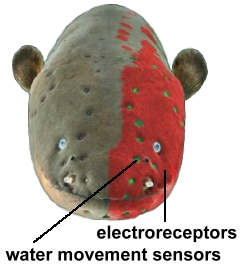 
There are three species of elongated South American knifefishes that produce powerful electric shocks to stun prey, usually other fish. We call them electric eels, although they are not true eels. All three species - the electric eel (Electrophorus electricus), Variís electric eel (E. varii), and Voltaís electric eel (E. voltai) - are all found in the Amazon River or its tributaries. Electric eels can grow to two and a half metres long, and weigh more than 20 kilograms. Over two thirds of the eel's body is filled with specialized cells called electrocytes that store electricity like small biological batteries. They have three electric organs: the main organ, Hunter's organ, and Sach's organ, which are all made up of modified muscle cells. When the eel is threatened, or is attacking prey, these cells discharge simultaneously, emitting electrical discharges of at least 600 volts, five times the voltage of a standard U.S. wall socket, and an amount large enough to cause intense pain in humans.   The eels produce three different kinds of electrical discharges: low-voltage pulses for sensing their environment; short sequences of two or three millisecond, high-voltage pulses given off while hunting; and volleys of high-voltage, high-frequency pulses when the eel is capturing prey or defending itself.
The eels produce three different kinds of electrical discharges: low-voltage pulses for sensing their environment; short sequences of two or three millisecond, high-voltage pulses given off while hunting; and volleys of high-voltage, high-frequency pulses when the eel is capturing prey or defending itself. The electrical pulses the eel produces do not act on the muscles themselves but on the nerves that control the prey's muscles. This produces strong, involuntary muscle contractions. Electric eels sometimes curl their bodies around larger prey. This doubles the strength of the electric field between the electric eel's positive pole (near the head) and its negative pole (near the tail). The electric eel then delivers a series of shocks at one-millisecond intervals. Each shock forces involuntary muscle contractions that fatigue the prey's muscles, allowing the electric eel to more easily swallow it.  When an electric eel is fully submerged, its electrical discharge is weaker because the shock is distributed throughout the surrounding water. Stronger shocks are delivered by leaping out of the water or by extending the head up and out of the water to place its chin against a partially submerged animal.
When an electric eel is fully submerged, its electrical discharge is weaker because the shock is distributed throughout the surrounding water. Stronger shocks are delivered by leaping out of the water or by extending the head up and out of the water to place its chin against a partially submerged animal. The strength of the electric current delivered this way is not reduced by the water. The electric current enters the animal's body directly before traveling through the rest of its body and back into the water and to the tail of the electric eel, thereby completing the electric circuit. The eels are generally solitary, but Volta's electric eels work together, coordinating their movements and the timing and strength of their electrical discharges to ambush or corral schools of fish before stunning and capturing individual prey.  Strangely, electric eels also eat fruit that falls from trees whose canopies overhang the rivers. Electric eels are generally sluggish, and prefer slow-moving fresh water, where they surface every few minutes to breathe; their blood vessel-rich mouth acts as a lung. The small gills are used only to eliminate carbon dioxide, not for obtaining oxygen. |